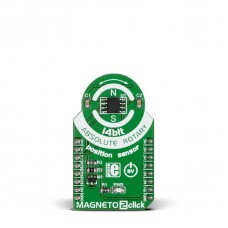MAGNETO 2 click
In combination with the correct library, the magnetic flux density of a small magnet (diametral magnetisation) rotating above the IC can be measured in a non-contacting way.
The sensor enables the design of novel generation of non-contacting rotary position sensors that are frequently required for both automotive and industrial applications.
Magneto 2 click communicates with the target MCU through the mikroBUS™ SPI bus. The board is designed to use a 5V power supply only.
Specification
| Type | Motion |
| Applications | Absolute Rotary Position Sensor, Pedal Position Sensor, Float-Level sensor, and Throttle Position Sensor |
| On-board modules | Melexis's MLX90316 monolithic rotary position sensor |
| Key Features | Triaxis® Hall Technology, Programmable Angular Range up to 360 Degrees |
| Key Benefits | CRC checks for even higher accuracy, Multiple filter settings for higher accuracy |
| Interface | SPI |
| Input Voltage | 5V,5V |
| Compatibility | mikroBUS |
| Click board size | S (28.6 x 25.4 mm) |
Documentation
Magneto 2 click is a mikroBUS™ add-on board with Melexis's MLX90316 monolithic rotary position sensor.
Sensing flux density with the IC surface of the MLX90316 allows the click to decode the absolute rotary (angular) position from 0 to 360 degrees.
In combination with the correct library, the magnetic flux density of a small magnet (diametral magnetisation) rotating above the IC can be measured in a non-contacting way.
Features and usage notes
- Tri⊗is® Hall Technology
- 40 bit ID number
- Single Die - SO8 or Dual Die (Full Redundant) - TSSOP16, RoHS Compliant
- Absolute Rotary Position Sensor IC
- Changeable main frequency for DSP chip (7MHz or 20 MHz master clock)
- Hysteresis Filter
- FIR and IIR filters for higher output accuracy
- Programmable Linear Transfer Characteristic
- SPI interface
- 5V Power Supply
Programming
This code initialises UART and SPI, reads data from the Magneto 2 click, and, if the readings are successful, prints it out on the UART
1 void main() {
2 char txt[20];
3 uint8_t check = 0;
4 float angle = 0.0;
5 UART1_Init_Advanced( 9600, _UART_8_BIT_DATA,
6 _UART_NOPARITY,
7 _UART_ONE_STOPBIT,
8 &_GPIO_MODULE_USART1_PA9_10 );
9 Delay_ms(300);
10
11 UART1_Write_Text("Uart initializedrn");
12 GPIO_Digital_Output( &GPIOD_BASE, _GPIO_PINMASK_13 ); // set CS pin as output
13
14 // Initialize SPI
15
16 SPI3_Init_Advanced(_SPI_FPCLK_DIV64, _SPI_MASTER |
17 _SPI_8_BIT | _SPI_CLK_IDLE_LOW |
18 _SPI_SECOND_CLK_EDGE_TRANSITION |
19 _SPI_MSB_FIRST |
20 _SPI_SS_DISABLE |
21 _SPI_SSM_ENABLE |
22 _SPI_SSI_1, &_GPIO_MODULE_SPI3_PC10_11_12);
23 SPI_Set_Active(&SPI3_Read, &SPI3_Write); // Sets the SPI1 module active
24
25
26 while (1)
27 {
28 check = read_mlx();
29 if ( check == 0) // if read was successful, print success and angle
30 {
31 Uart1_Write_Text("Success rn");
32 angle = (float) mlx.angle;
33 angle /= 45.5;
34 floattostr(angle,txt);
35 Uart1_Write_Text(txt);
36 Uart1_Write_Text("rn");
37 }
38 else // else print fail
39 Uart1_Write_Text("Fail rn");
40
41 Delay_ms(400); // Wait 400ms
42 }
43 }
Code example that demonstrates the usage of Magneto 2 click with MikroElektronika hardware, written for mikroC for ARM is available on Libstock.
Downloads
Enter the code in the box below:








